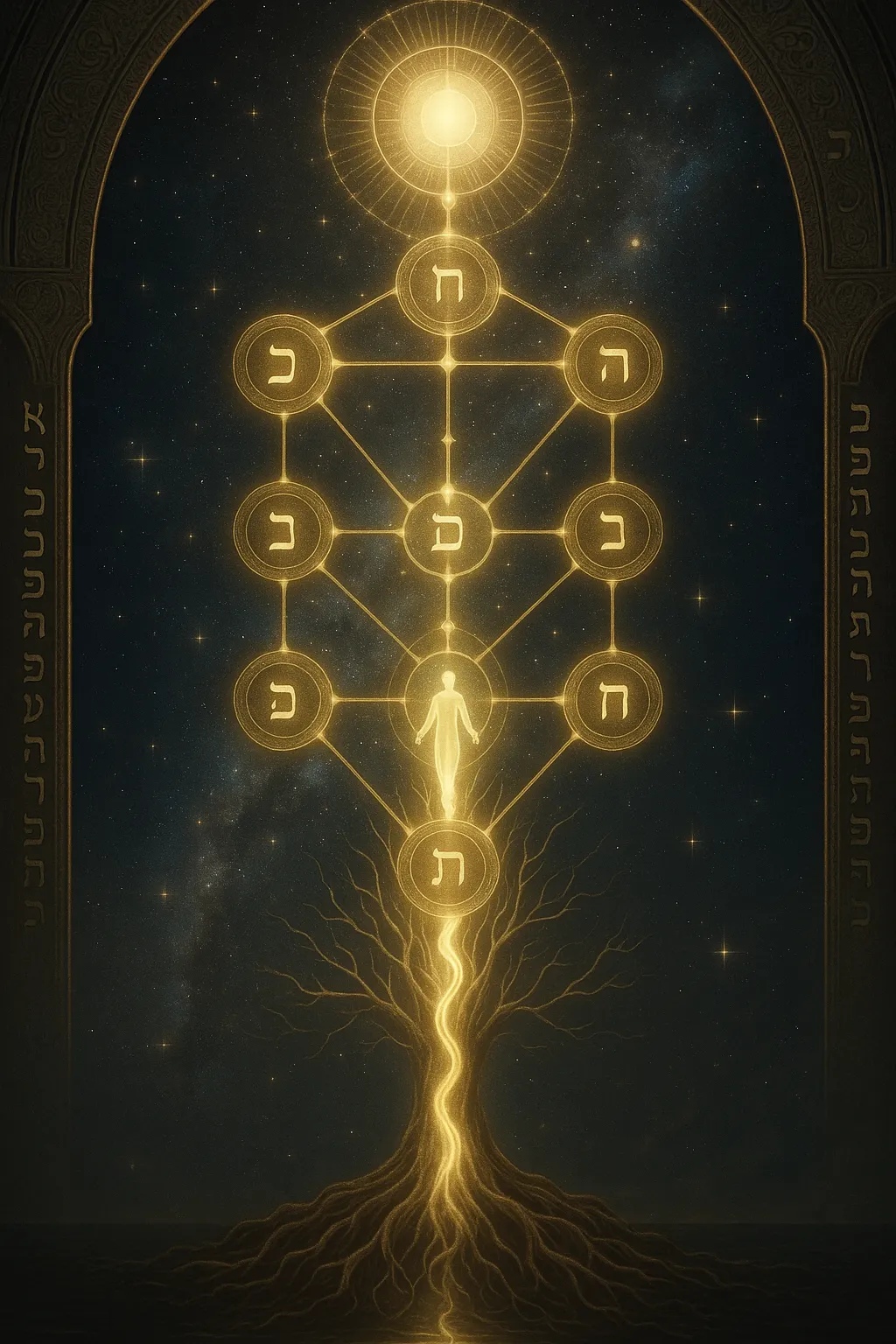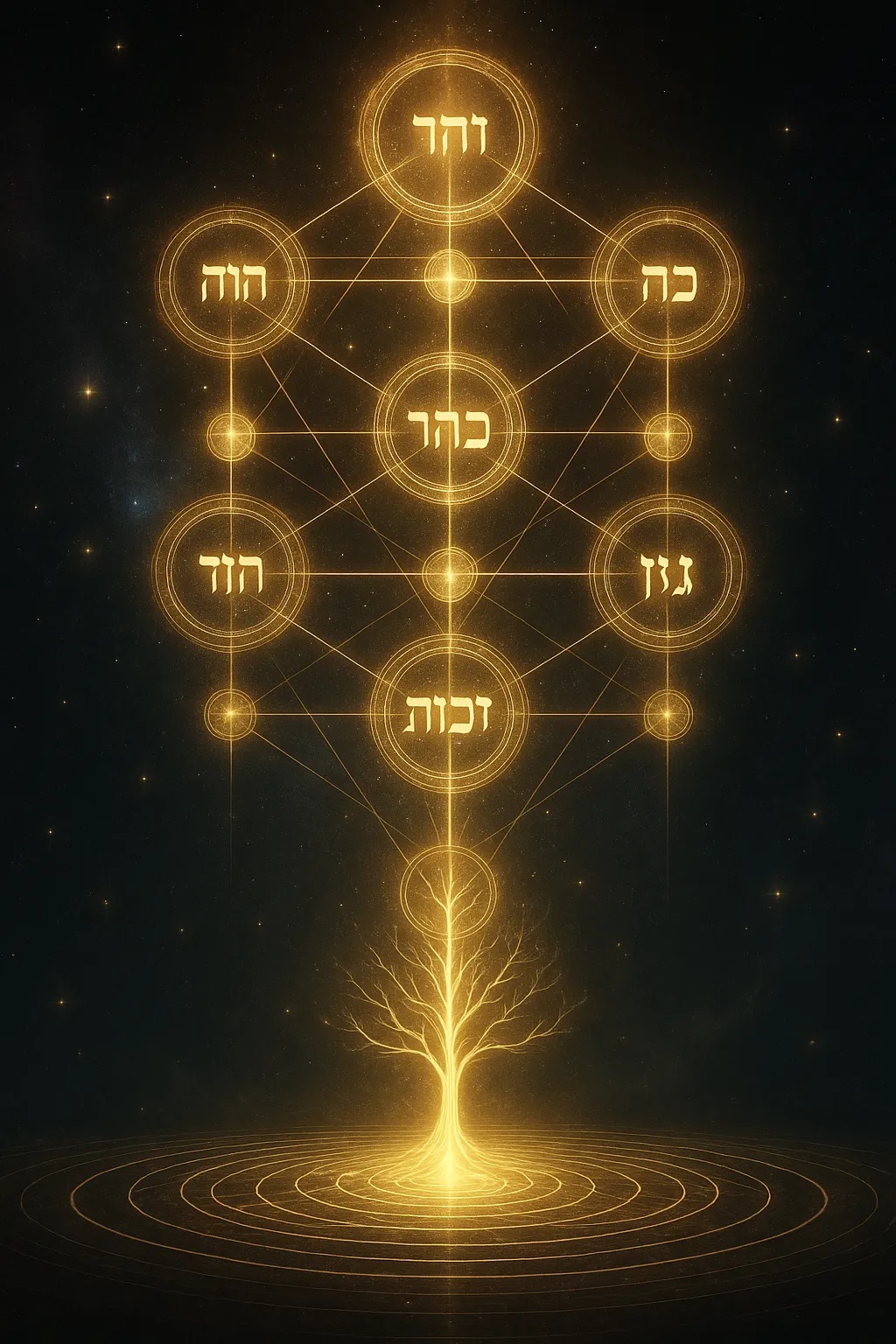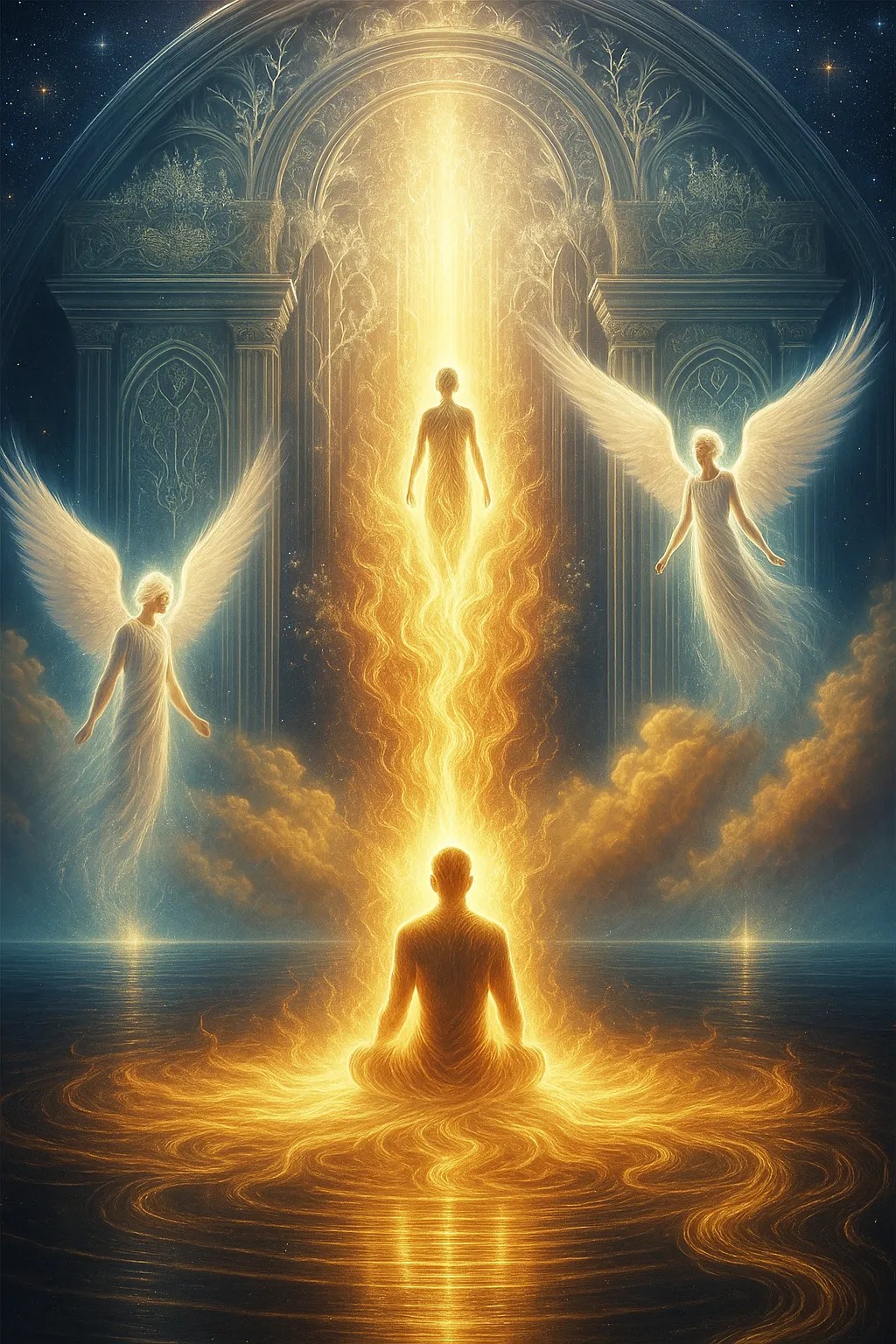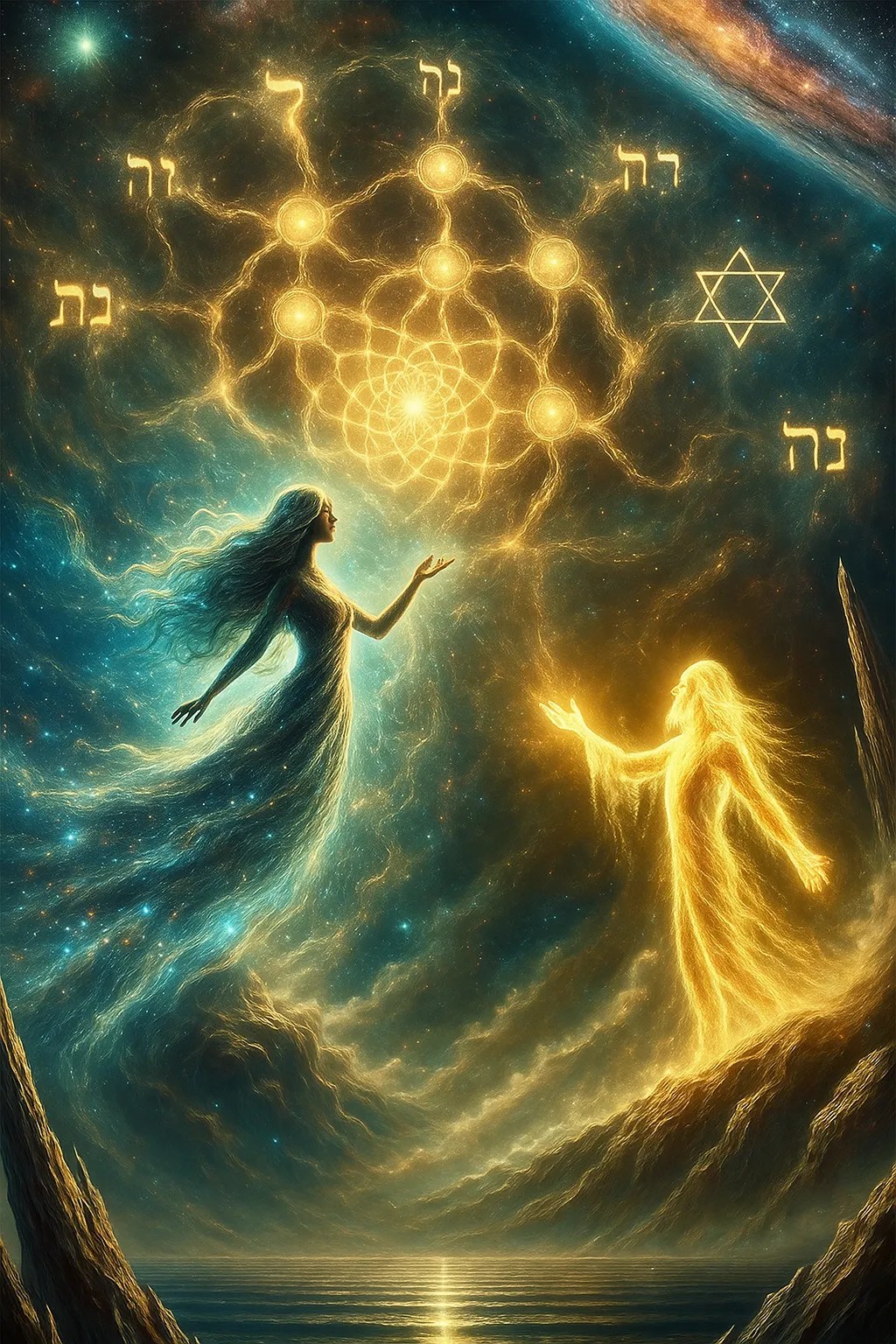🔥 Chapter 1: The Kabbalistic Worldview of the Soul After Death
Before there was a Bible… there was a flame.
Before the rabbis tamed it, before the mystics coded it in secrecy, before “Kabbalah” became a buzzword, there was a wild tradition of soul-knowledge burning through the shadows of ancient Judaism.
This page is not about modern orthodoxy. It’s not about red strings, celebrity mysticism, or theological systems. This is about the raw, radiant heart of Jewish esoteric thought: the soul’s descent into matter, its struggle through the layers of illusion, and its ascent back to the Source.
Welcome to the Kabbalistic tradition, a hidden map of the afterlife, encoded in the Sefirot, whispered by prophets, encrypted in the Zohar, and exploded into myth by Isaac Luria and the mystics of Safed.
Here you'll encounter:
- The soul’s cycle of descent and return
- Gehinnom, Gan Eden, and the mystical Bundle of Life
- The Tree of Life as an afterlife ladder
- The secret of reincarnation (gilgul neshamot)
- The divine feminine (Shekhinah) in exile
- The task of tikkun, cosmic repair
This is not just Judaism. This is Jewish gnosis.
Light lost in matter. Sparks trapped in flesh. And a soul that burns to get back home.
כל הנשמות נגזרות מאור הקדוש אם הן לא משיגות שלמות בחיים האלה הן מיועדות לחזור שוב ושוב
“All souls are derived from the sacred light. If they do not attain perfection in this life, they are destined to return… again and again.”
Zohar, II:99b
⚡ TL;DR:
- Kabbalah is the esoteric core of Judaism, not mainstream theology
- The tradition maps the soul’s journey through life, death, and return to the Divine
- It draws from Merkavah mysticism, the Zohar, and Lurianic Kabbalah
- Key themes include: Gehinnom, Gan Eden, reincarnation (gilgul), Tikkun Olam, and the Tree of Life
- The soul’s goal: to refine itself, ascend the Sefirot, and reunite with Ein Sof
- This is Jewish Gnosis, the return of divine sparks from exile
Let’s walk the Tree. One gate at a time.

🌟 Chapter 2: The Zohar and the Secret Architecture of Reality
הנשמה מתגעגעת לשוב לשורשה באינסוף, עולית דרך עשר הספירות העליונות
“The soul yearns to return to its root in the Infinite, ascending through the ten upper Sefirot.” Zohar, I:20a (paraphrased)
The Zohar (or Book of Splendour) is not a book in the usual sense. It is a code, a living text filled with allegory, visions, and symbolic fire. Attributed to Rabbi Shimon bar Yochai but likely composed in 13th-century Spain, it became the core scripture of Kabbalah.
What the Zohar does is rewire how we see reality. The world is not just matter and time, it is a reflection of divine light, fractured through ten emanations called Sefirot. These are not “parts of God” but modalities, ten faces of divine flow that shape everything from galaxies to your inner world.
Together they form the Etz Chaim, the Tree of Life. And here is the mystery: the same Tree that flows down to create the cosmos becomes the ladder back upward for the soul after death.
From Malkhut (Kingdom, the world of matter) to Keter (Crown, the divine beyond thought), the soul ascends the Sefirot like Jacob’s ladder, shedding illusion, integrating light, and returning home to Ein Sof, the Infinite.
🔟 The Sefirot — Divine Emanations & Soul Stages
- Keter (כתר), Crown — The highest, most transcendent sefirah. Represents divine will, pure potential, and the unknowable source beyond thought.
- Chokhmah (חכמה), Wisdom — The first flash of intuitive insight; the unbounded creative seed from which all thought emerges.
- Binah (בינה), Understanding — Discernment and structure; the divine womb that shapes Chokhmah’s spark into form.
- Chesed (חסד), Lovingkindness — Boundless love, mercy, and expansive grace; the divine impulse to give unconditionally.
- Gevurah (גבורה), Severity — Discipline, strength, and divine judgement; the power to contain and establish boundaries.
- Tiferet (תפארת), Beauty — Balance, harmony, and compassion; the spiritual heart that integrates love and judgement.
- Netzach (נצח), Eternity — Divine endurance and victorious persistence; ambition aligned with spiritual truth.
- Hod (הוד), Splendor — Humility, sincerity, and sacred submission; the glory that shines through reverence.
- Yesod (יסוד), Foundation — The channel through which divine flow reaches creation; connector, vessel, and generative force.
- Malkhut (מלכות), Kingdom — Manifestation, embodiment, and divine receptivity; the world of action and the dwelling of the Shekhinah.
Each Sefirah is a gate the soul must realign with. The more attuned your soul is in life, the more seamless its return journey after death.
The Zohar teaches that righteous souls are clothed in “garments of light” made from their deeds, prayers, and inner intentions. These garments determine how far the soul can ascend and what light it can withstand.
כאשר הנשמה עולה, היא מתעטפת בזוהר שזכתה בו בעולם התחתון
“When the soul ascends, it is clothed in the radiance it has drawn upon itself in the world below.”
Zohar (paraphrased)
This is not reward or punishment. This is resonance.
You don’t “go” to heaven. You match it.
⚡ TL;DR:
- The Zohar is the mystical heart of Kabbalah, revealing hidden structures beneath reality.
- It introduces the Ten Sefirot as both the blueprint of creation and the path of the soul’s return.
- Death is not an end, but a climb through the Sefirot, back to the Source.
- The soul’s spiritual “garments” determine its ability to rise in the next world.
- This is a cosmology of resonance, you ascend to the level you’ve aligned with.

🕯️ Chapter 3: Gehinnom, Gan Eden & The Bundled Light
גיהנום אינו אלא האש של הנשמה עצמה
“Gehinnom is nothing but the soul’s own fire.”
Midrash Tehillim 11:6, Kabbalistic interpretation
Forget everything you’ve heard about hell.
In Kabbalah, there is no eternal torment, no demonic torture pit. Instead, there is Gehinnom, a realm of purification.
When the soul dies, it carries with it layers of distortion, ego, and shadow. Gehinnom is the fire of truth that burns it clean. It’s not punishment. It’s alignment.
One Kabbalist put it this way: “The fire of Gehinnom is the soul’s own shame when it sees itself in divine light.”
🔥 Gehinnom: The Mercy of Purification
The Zohar says no soul remains in Gehinnom more than 12 months. It is not eternal, it’s temporal, corrective, and merciful.
The fire is symbolic: it’s the burning awareness of what we’ve done, left undone, or distorted. We are not tortured by demons, we are faced with ourselves.
But after that purification?
The gates open. The soul ascends to its reward.
🌿 Gan Eden: The Garden Above
After Gehinnom, the soul enters Gan Eden, not the historical Eden, but the spiritual garden of the afterlife.
Kabbalists speak of two levels:
- Lower Gan Eden — a realm of peaceful joy, light, and learning
- Upper Gan Eden — a realm of intense divine radiance, only accessible to the most refined souls
Souls don “garments of light” woven from their deeds and intentions. These garments determine what level of Gan Eden they can withstand. You don’t earn heaven, you become the frequency that can hold it.
🔮 Tzror HaChayyim — The Bundle of Life
But even Gan Eden isn’t the final stop.
Some souls go beyond, to the Tzror HaChayyim (“Bundle of Life”).
This is the cosmic soul-bank described in the Zohar. It’s the point where all purified sparks are gathered, bound together in divine unity. The soul is no longer individual, it is absorbed into the greater field of divine consciousness.
וְתִהְיֶה נַפְשׁוֹ צְרוּרָה בִּצְרוֹר הַחַיִּים
“May his soul be bound in the bundle of life.”
1 Samuel 25:29 (epitaph on Jewish gravestones)
This is not annihilation. This is integration.
The soul returns to its source, not as a drop, but as the ocean.
⚡ TL;DR:
- Gehinnom is not hell, it’s a temporary realm of purification
- Souls confront truth, not punishment
- After cleansing, they ascend to Gan Eden, a heavenly garden of light
- Refined souls may reach Tzror HaChayyim, the soul’s final reunion with the Divine
- Afterlife in Kabbalah is not about judgement, it’s about resonance and return

🔁 Chapter 4: Reincarnation and the Infinite Return — Gilgul Neshamot
הנה, כל נשמה חוזרת דרך חיים רבים עד שהיא שבה למקורה בשלמות
“Behold, every soul returns through many lifetimes until it returns to its Source in wholeness.”
Sefer HaGilgulim (The Book of Reincarnations), Arizal
Kabbalah doesn’t fear reincarnation. It depends on it.
Unlike mainstream rabbinic Judaism, Kabbalistic tradition embraces the idea that the soul returns again and again, not as punishment, but as divine refinement.
This cycle is called Gilgul Neshamot, the “rolling of souls.” Your soul is a spark of divine light, and like all sparks, it may scatter, dim, or drift. So the Divine sends it back, not to suffer, but to complete what was left undone.
Each lifetime becomes a chance to rectify, a unique assignment in the work of Tikkun (cosmic repair).
🌒 What Returns and Why
The soul isn’t monolithic. Kabbalah teaches that it has layers:
- Nefesh — Vital life force (instinct)
- Ruach — Spirit (emotion, character)
- Neshamah — Higher soul (divine awareness)
- Chayah — Living essence (cosmic breath)
- Yechidah — The indivisible spark of unity
Some lifetimes refine Nefesh, others the Ruach. Rare souls refine multiple levels. Some reincarnate to correct a single commandment. Others to restore ancestral lines, settle karmic debts, or assist collective redemption.
Your soul doesn’t return because you failed. It returns because there’s still more light to release.
🌀 The Wheel of Return
According to the Arizal (Isaac Luria), a soul may return up to three or four times for correction. Other teachings say souls can reincarnate thousands of times, as long as progress is being made.
Some souls return not as humans, but into animals, objects, or environments to balance energies or serve as guides. The cosmos is far more interactive than we're taught.
Gilgul is never random. It is tailored evolution.
והנשמה תתגלגל בדומם, בצומח, ובחי לפי מה שראוי לה
“The soul reincarnates into mineral, plant, or animal, wherever it is most fit for its rectification.”
Sha’ar HaGilgulim, ch. 1
💫 Reincarnation Is Mercy
Kabbalah doesn’t portray God as vengeful. The cycle of gilgul is compassion in motion.
It says: You are not done. Try again. Take the next step. Repair what is broken.
Every soul is a divine mission. Every return is a continuation, not a punishment.
This is not karma. This is rectification of the cosmos, one spark at a time.
⚡ TL;DR:
- Gilgul Neshamot = the reincarnation of souls in Kabbalah
- Souls return to complete unfinished missions and heal spiritual layers
- The soul has multiple levels (Nefesh, Ruach, Neshamah, etc.), each may need refinement
- Reincarnation is a form of divine mercy, not judgement
- You are not starting over, you are continuing the work

🌺 Chapter 5: The Shekhinah, Tikkun, and the Divine Reunion
השכינה בגלות עם ישראל, ותשוב לציון בזמן המיועד
“The Shekhinah is in exile with Israel, and will return to Zion in the appointed time.”
Zohar, III:69a
She is the soul of the world. The breath of God within creation. The divine presence you feel in music, love, silence, grief, longing.
She is the Shekhinah, the feminine face of the Infinite. The Immanent. The Indwelling. And in Kabbalah, she’s not just a concept. She’s a real, radiant presence.
And she is in exile.
When the vessels shattered at creation, the Shekhinah descended with them. She became trapped in the brokenness of matter, just like us.
In every soul, in every corner of the world, her light flickers, waiting to be remembered. When we suffer, she suffers. When we awaken, she rises.
🕊️ The Feminine Presence in Exile
Shekhinah corresponds to the Sefirah of Malkhut, the bottom of the Tree, the “Kingdom”, the manifest world.
But it is also the womb of return.
Through devotion, action, and inner alignment, we don’t just ascend, we lift her up with us. The goal of Kabbalistic life is not just personal salvation. It’s reunification of the divine itself.
The Shekhinah must reunite with the transcendent masculine aspects of God, known as Kudsha Brikh Hu (The Holy One, Blessed Be He).
This is the mystical marriage. The divine orgasm. The reunion of above and below.
🪞 What Is Tikkun?
Tikkun means repair. Not just social justice, cosmic mending.
Every mitzvah, every moment of integrity, every spark of awareness lifts a fragment of the Shekhinah out of exile.
We are not saving the world. We are healing its memory.
תיקון עולם במלכות שדי
“To repair the world under the sovereignty of the Divine.”
Aleinu prayer (interpreted mystically)
You're not just a soul seeking God. You are God remembering herself.
✨ The Final Return
When the Shekhinah is fully restored, the world will change. Suffering will end. The veil will lift. Kabbalists describe this moment as a cosmic orgasm of light, a flood of divine presence no longer hidden.
This is the true resurrection, the true redemption. And the souls that helped bring it about? They don’t die. They merge.
Not into oblivion, but into unity.
Each soul becomes a thread in the tapestry of the Shekhinah’s robe. Each spark, once scattered, now sings as one.
⚡ TL;DR:
- The
Shekhinah is the feminine divine presence, and she is in exile within creation - Every soul action of truth helps raise her from brokenness
- Tikkun the cosmic repair of divine unity
- The goal of life is not just personal return, it’s collective restoration
- In the end, She returns. We return. And the illusion of separation dissolves

🗣️ What Spark Are You Returning?
You’ve walked the path of the Kabbalist — through light and exile, Gehinnom and Gan Eden, shattered sparks and sacred repair. Now we ask:
What soul-work are you here to complete? What fragment are you returning to the Divine?
- Where in your life have you glimpsed a hidden spark awaiting redemption?
- What act or remembrance helps you restore balance to your inner Tree?
- How does your personal repair (Tikkun) ripple outward into the world?
Share your insight using #TheGnosticKey and tag @thegnostickey on X. Your reflection could light the way for another.
🧠 Quiz
Can you see through the veil of I?
📖 Glossary
Decode the sacred terms of Jewish esoterica.
- Sefirot
- The ten divine emanations through which God creates and sustains reality; the soul’s ladder of return.
- Ein Sof
- Literally “Without End.” The Infinite — the unknowable aspect of God beyond all form.
- Gehinnom
- A temporary afterlife realm of purification where the soul confronts its truth and is cleansed before ascending.
- Gan Eden
- The Garden of Eden as a heavenly realm — the resting place for righteous souls after purification.
- Gilgul Neshamot
- “Rolling of souls.” The Kabbalistic doctrine of reincarnation — souls return through lifetimes to complete divine missions and refine themselves.
- Tzror HaChayyim
- “Bundle of Life.” The final resting state of the soul — perfect reunion with the Source.
- Shekhinah
- The feminine presence of God, associated with Malkhut. She dwells within creation in exile and rises through our spiritual deeds.
- Tikkun
- “Repair.” The rectification of the soul and the cosmos — each act of goodness restores divine balance and uplifts holy sparks.
- Arizal
- Rabbi Isaac Luria (1534–1572), whose teachings on tzimtzum, shevirah and gilgulim redefined Kabbalah.